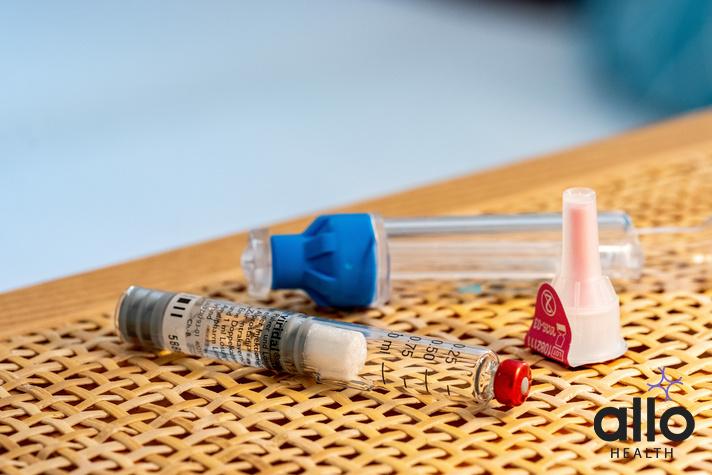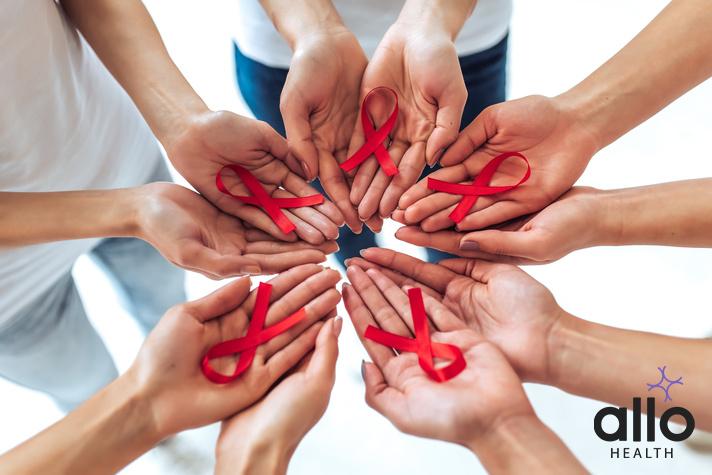What Are The Causes Of HIV?

Allo Health is dedicated to personalized well-being, offering support and trusted information tailored to individual health goals. The platform emphasizes human-generated content, led by a distinguished medical team of experts, including physicians and sexual health specialists. Their commitment to credibility involves rigorous fact-checking, authoritative research, and continuous updates to ensure accurate, up-to-date information. Allo Health's unique approach goes beyond conventional platforms, providing expert-led insights and a continuous commitment to excellence, with user feedback playing a crucial role in shaping the platform's authoritative voice.

Dr Sanina Mansoor holds MBBS degree from Yenepoya university,Mangalore.She has 8 years of experience working as a medical officer at various health centres and medical colleges.
Why This Was Upated?
Our experts continually monitor the health and wellness space, and we update our articles when new information became available.
Updated on 08 May, 2024
- Article was updated as part of our commitment to diversity, equity, and inclusion.

"The following blog article provides general information and insights on various topics. However, it is important to note that the information presented is not intended as professional advice in any specific field or area. The content of this blog is for general educational and informational purposes only.
Book consultation
The content should not be interpreted as endorsement, recommendation, or guarantee of any product, service, or information mentioned. Readers are solely responsible for the decisions and actions they take based on the information provided in this blog. It is essential to exercise individual judgment, critical thinking, and personal responsibility when applying or implementing any information or suggestions discussed in the blog."
HIV, or Human Immunodeficiency Virus, is a virus that attacks the body’s immune system, specifically targeting CD 4 cells, also known as T-helper cells. These cells are crucial for the immune system’s function, as they coordinate the body’s response to infections. When HIV infects these cells, it weakens the immune system over time, making the body vulnerable to various infections and diseases. Understanding the causes of HIV is essential for prevention and management.
Overview Of The Primary Causes Of HIV
- Sexual Transmission:
One of the most common modes of HIV transmission is through sexual contact, particularly unprotected vaginal, anal, or oral sex with an infected individual. The virus can enter the body through mucous membranes or breaks in the skin during sexual activity. Factors such as multiple sexual partners, inconsistent condom use, and engaging in high-risk sexual behaviours increase the risk of HIV transmission through sexual contact. - Sharing Needles and Syringes:
 HIV can spread through sharing needles, syringes, or other injection equipment contaminated with infected blood. This mode of transmission is significant among people who inject drugs (PWID) and can occur during the injection of illegal drugs, medications, or even in healthcare settings where equipment is not adequately sterilised between uses.
HIV can spread through sharing needles, syringes, or other injection equipment contaminated with infected blood. This mode of transmission is significant among people who inject drugs (PWID) and can occur during the injection of illegal drugs, medications, or even in healthcare settings where equipment is not adequately sterilised between uses. - Mother-to-Child Transmission (Vertical Transmission):
HIV can be transmitted from an infected mother to her child during pregnancy, childbirth, or breastfeeding. Without intervention, the risk of vertical transmission is around 15-45%. However, with proper medical care, including antiretroviral therapy (ART) during pregnancy and delivery, as well as safe infant feeding practices, the risk of transmission can be significantly reduced to less than 1%. - Blood Transfusions and Organ Transplants:
In the past, HIV transmission occurred through blood transfusions and organ transplants from infected donors. However, stringent screening measures and testing protocols have significantly reduced the risk of HIV transmission through these routes in countries with well-established healthcare systems. - Occupational Exposure:
Healthcare workers and first responders may be at risk of HIV transmission through occupational exposure to infected blood or bodily fluids. This can occur through needle-stick injuries, cuts, or contact with mucous membranes (e.g., eyes, mouth) with contaminated blood or fluids. Adhering to universal precautions, using personal protective equipment (PPE), and following proper infection control protocols minimise the risk of HIV transmission in healthcare settings. - Non sterile Medical Procedures:
 In settings with limited resources or inadequate infection control practices, HIV transmission can occur through non sterile medical procedures involving contaminated equipment, such as syringes, surgical instruments, or dental tools. Unsafe healthcare practices contribute to the spread of HIV and other blood-borne infections, highlighting the importance of improving healthcare infrastructure and implementing universal precautions.
In settings with limited resources or inadequate infection control practices, HIV transmission can occur through non sterile medical procedures involving contaminated equipment, such as syringes, surgical instruments, or dental tools. Unsafe healthcare practices contribute to the spread of HIV and other blood-borne infections, highlighting the importance of improving healthcare infrastructure and implementing universal precautions. - Sexual Violence:
In cases of sexual violence, such as rape or sexual assault, HIV transmission can occur if the perpetrator is HIV-positive and there is unprotected sexual contact. Survivors of sexual violence are at increased risk of HIV and other sexually transmitted infections (STIs), emphasising the need for comprehensive support services, including medical care, counselling, and access to HIV prevention methods like post-exposure prophylaxis (PEP). - Stigma and Discrimination:
Although not a direct cause of HIV transmission, stigma, discrimination, and lack of awareness contribute to the spread of HIV by creating barriers to testing, treatment, and prevention services. Fear of stigma or discrimination may prevent individuals from seeking HIV testing, disclosing their HIV status, or accessing essential healthcare services, leading to increased transmission rates within communities.
HIV transmission can occur through various routes, including sexual contact, sharing needles, mother-to-child transmission, blood transfusions, occupational exposure, non sterile medical procedures, sexual violence, and societal factors like stigma and discrimination. Effective prevention strategies focus on promoting safer sexual practices, ensuring access to harm reduction services for PWID, implementing routine HIV testing and counselling, providing comprehensive healthcare for pregnant women living with HIV, improving infection control measures in healthcare settings, addressing sexual violence, and supporting survivors, and combating HIV-related stigma and discrimination. Early diagnosis, prompt initiation of antiretroviral therapy, and ongoing support and care are essential for managing HIV infection and improving overall health outcomes.
Most Asked Questions
-
What is HIV, and how does it spread?
HIV (Human Immunodeficiency Virus) is a virus that attacks the immune system, specifically targeting CD4 cells, which are crucial for fighting infections. HIV spreads through contact with certain bodily fluids, such as blood, semen, vaginal fluids, and breast milk. This transmission can occur during unprotected sex, sharing needles or syringes, and from mother to child during pregnancy, childbirth, or breastfeeding.
-
What are the primary modes of HIV transmission?
The primary modes of HIV transmission include unprotected sexual intercourse with an infected person, sharing needles or syringes contaminated with HIV-infected blood, and from an HIV-positive mother to her child during pregnancy, childbirth, or breastfeeding. HIV can also be transmitted through blood transfusions or organ transplants if the blood or organs are not screened for the virus.
-
What are the risk factors for contracting HIV?
Several factors increase the risk of contracting HIV, including engaging in unprotected sexual intercourse with multiple partners or with partners whose HIV status is unknown, sharing needles or syringes for injecting drugs, having a sexually transmitted infection (STI), and receiving blood transfusions or organ transplants without proper screening. Additionally, infants born to HIV-positive mothers are at risk of acquiring the virus during pregnancy, childbirth, or breastfeeding.
-
Can HIV be transmitted through casual contact or everyday activities?
HIV cannot be transmitted through casual contact such as hugging, kissing, shaking hands, sharing utensils or food, or through insect bites. It is not spread through air, water, or by touching objects handled by an HIV-positive person unless those objects are contaminated with blood or other bodily fluids containing the virus. Everyday activities do not pose a risk of HIV transmission.
-
What are some misconceptions about HIV transmission?
Several misconceptions about HIV transmission contribute to stigma and discrimination. One common misconception is that HIV can be spread through casual contact, which is not true. Another misconception is that HIV only affects certain groups of people, whereas anyone engaging in risky behaviors or coming into contact with infected bodily fluids can contract the virus. It's important to rely on accurate information and education to combat misconceptions about HIV transmission.

 HIV can spread through sharing needles, syringes, or other injection equipment contaminated with infected blood. This mode of transmission is significant among people who inject drugs (PWID) and can occur during the injection of illegal drugs, medications, or even in healthcare settings where equipment is not adequately sterilised between uses.
HIV can spread through sharing needles, syringes, or other injection equipment contaminated with infected blood. This mode of transmission is significant among people who inject drugs (PWID) and can occur during the injection of illegal drugs, medications, or even in healthcare settings where equipment is not adequately sterilised between uses. In settings with limited resources or inadequate infection control practices, HIV transmission can occur through non sterile medical procedures involving contaminated equipment, such as syringes, surgical instruments, or dental tools. Unsafe healthcare practices contribute to the spread of HIV and other blood-borne infections, highlighting the importance of improving healthcare infrastructure and implementing universal precautions.
In settings with limited resources or inadequate infection control practices, HIV transmission can occur through non sterile medical procedures involving contaminated equipment, such as syringes, surgical instruments, or dental tools. Unsafe healthcare practices contribute to the spread of HIV and other blood-borne infections, highlighting the importance of improving healthcare infrastructure and implementing universal precautions.







































